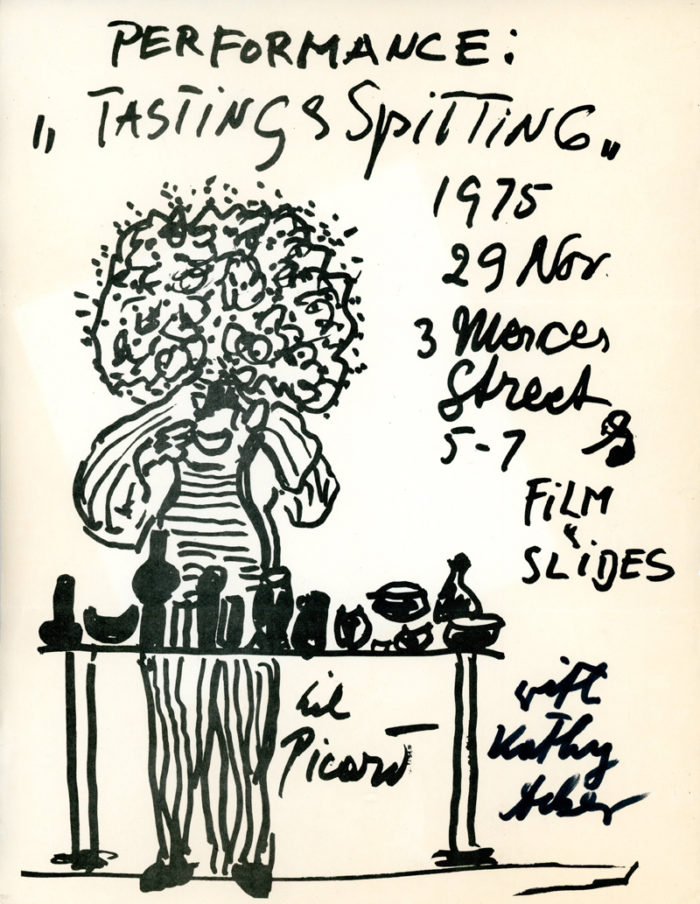Collectors of art ephemera who focus on the career of a favorite artist highly prize cards and flyers that include a portrait of the artist. Ephemera of this kind is surprisingly rare as most galleries and museums prefer to promote the works being exhibited rather than the artist.
Gallery 98 has dug deep into its inventory and presents here some prime examples of ephemera featuring portraits of artists who occupy a significant place in the history of art.
William Pope.L

Franklin Furnace, George is in the Lake, a performance organized by William Pope.L and Jim Calder, Flyer with ink notations, January 1989.
Size: 8.5 x 11 inches
The flyer advertises an early theater work by William Pope.L, the famous street performance artist, who had a retrospective at MoMA last year. A 1989 press release by William Pope.L and Jim Calder for the Franklin Furnace event reads: “A metal barge carries the noble General George Washington across the ice when, WHAP!, the General teeters and falIs beneath the icy folds. A seriously funny feminist fairy tale, George is in the Lake, asks the question, What if George Washington had not crossed the Delaware? The answer is found in this anti-war, pro-gay, deconstructionist musical theater.”
Laurie Anderson

Hunter College Art Gallery, ENDGAME: Strategies of Postmodernist Performance, Robert Morris, Laurie Anderson, Robert Longo, Card 1984. Photo of Laurie Anderson is by Paula Court.
Size: 6 x 4 inches.
This heavy with theory 1984 exhibition included “typical” works by Robert Morris, Laurie Anderson and Robert Longo, each representing a different decade — the 60s, 70s and 80s. According to curator Maurice Berger, “The offensive waged by Minimal art has resulted in the death of the static art object and the triumph of temporal experience.” Anderson’s work with its use of slide projections, synthesized sound, and film approaches performance.
Julian Schnabel

Mary Boone Gallery, Julian Schnabel, Folded Card, April 4 – May 7, 1981.
Size: 10 x 7 inches (Unfolded)
This historically significant card announces Julian Schnabel’s breakthrough two-gallery exhibition at the Mary Boone and Leo Castelli Galleries (although inexplicably only the name of the Boone Gallery appears on this card). Steeped in the mystique of modernism, Schnabel mimics the famous photograph of artist Yves Klein’s Leap into the Void. The photo is by downtown film director Amos Poe who shared Schnabel’s taste for the “romantic” existentialism found in French culture during the early 1960s.
Miriam Schapiro

Thomas Segal Gallery, Miriam Schapiro, Geometry and Flowers: Works on Paper & Paintings, Card, April 9 – May 4, 1983.
Size: 4.75 x 7 inches
In the early 1970s Schapiro (1923-2015) emerged at the forefront of the feminist art movement partnering with Judy Chicago in the establishment of the Feminist Art Program at California Institute of the Arts, and in the creation of Womanhouse in Downtown Los Angeles. As a leader of the Pattern and Decoration movement Schapiro enjoyed enough success by the mid-1970s to afford her own studio. According to one biographer, Schapiro’s studio was more than a workspace. It also had a symbolic meaning for her — a room of her own where she could fulfill her dreams free of the constraints of gender roles.
Judy Chicago

Judy Chicago, Re:Vision, Opening of exhibition and reception for publication of Judy Chicago’s book Through the Flower, Folded Card, 1975.
Size: 7 x 11 inches.
This short one-week exhibition in Santa Monica, California, was concurrent with the creation of Chicago’s most famous work The Dinner Party (1974-1979). In contrast to that monumental project, this show promises “art on an intimate scale.” The title Re:Vision alludes to looking back and seeing something in a new way, a concept central not only to the feminist slant of The Dinner Party but also to the re-evaluation of the concept of sexuality in the 1970s. The card promises “Some Erotic Images,” along with a book signing for Chicago’s newly published Through the Flower: My Struggle as a Woman Artist (1975).
Willem de Kooning

Matthew Marks Gallery, Willem de Kooning, Paintings 1983-84, Card, January 25 – March 29, 1997
Size: 7 x 5 inches
Willem de Kooning (1904-1997) was alive when this exhibition opened, but passed away just days before it closed. As de Kooning was stricken with Alzheimer’s and stopped making art in 1991, the paintings in this exhibition were from 1983-84. The 1982 color portrait of de Kooning on the card is by Hans Namuth.











